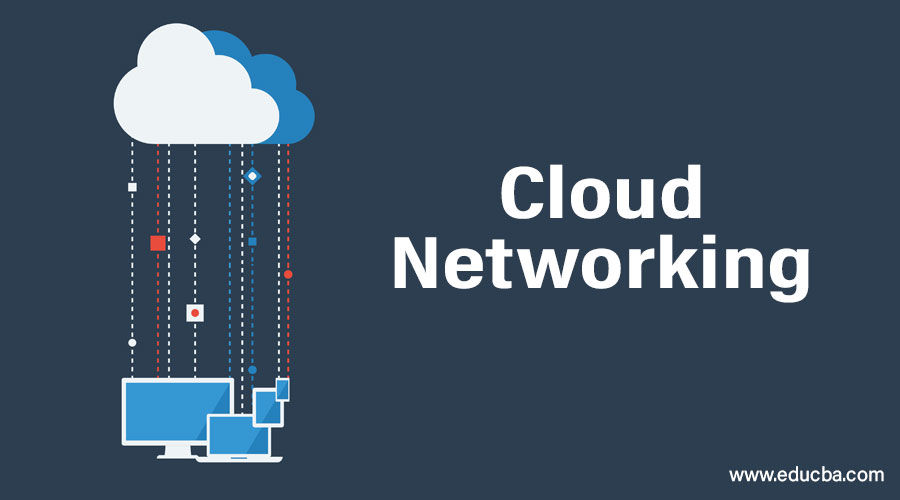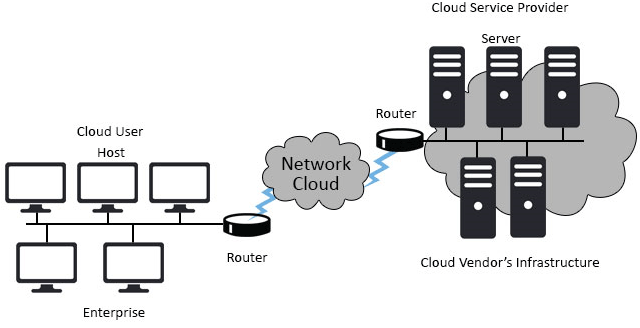Updated March 21, 2023

Introduction to Cloud Networking
Cloud Networking is a service or technology in which the company’s networking process is hosted on a public or private cloud. Cloud Computing is a source control in which multiple computing resources share the same platform, and the users are also enabled to access these resources to a particular extent. Cloud networking similarly shares the networking, but it provides more advanced features and network functions in the cloud with interconnected servers established under cyberspace.
Why Cloud Networking?
Know why cloud networking is required and in demand:
- Many organizations are in demand for their fast and secure delivery, rapid processing, and reliable transmission of data without any loss, pocket-friendly set-up. The benefit of companies who prefer Cloud Networking includes web service providers, e-commerce, cloud service providers, network operators, and cloud service providers.
- It allows users to develop their networks according to the requirements of cloud-based services. An authentic cloud network offers high-end monitoring to the globally located servers, controls the traffic flow between interconnected servers, protects the systems with advanced network security and gives visibility to the user by its centralized management. Internet access can be improved and made more reliable bandwidth to promote multiple network functions into the cloud.
- The above diagram shows the operation of Cisco. It shows the separation of resources from the user, and then they connect it with the cloud. It includes the management of distributed wireless access to the routers, and in addition to it provides all the high-tech features as mentioned above. The aim is to design and manage new cloud networks with more secured private access by a wide area network.
- Software-Defined Wide Area Network is a technology that uses a bunch of networking switches and routers to virtually access the device from hardware to software deployed on a white box. Confidential devices and data are installed on the main branch office or client location and given special access to the administrator to access its advanced networking functions, cloud optimization software, and firewalls. It is a huge range of array with network functions deployed in the cloud platform.
- It ensures performance and security in a multi-cloud environment so that Information technology gets more visibility by providing end-users with the requirements and experience they need. Workloads are shared between the cloud environment using the software as a service application. The protection is given to the user to access the web page and infrastructure by moving the applications to the cloud with a typical security model. The gateway provides a contextual access code and a multilayer firewall. Applications and services are given to distributed data centers in a cloud environment.
- Software-defined Wide range network gives the traditional load balancing method and combines all ranges of the network to user experience. It gives more visuality with the help of intelligent analytics. Giving solutions to each cloud user may be difficult, but the leverage of all the services and offering them a unique solution by SD-WAN from end to end applications.
Benefits of Cloud Networking
Given below are the benefits mentioned:
- High Scalability: It requests the supply of resources on a huge scale without any human intervention with each service provider.
- High availability and Reliability: The servers are available at the right time without any delay or disappointment.
- Agility: It shares the resources effectively among the users and works quickly.
- Multi-sharing: By distributed computing, different clients from multiple areas share the same resources by fundamental infrastructure.
- Maintenance: It is user-friendly as they are easy to access from their place and doesn’t require any installation setup.
- Low Cost: It is very cost-effective and pays according to its usage.
- Services in pay per use Model: Application Programming Interface is given to customers to use resources and services and pay on a service basis.
- On-Demand Self Service: Cloud computing offers the required services and applications to the client. With the login key, they can start to use it without any human interaction and cloud service providers. It includes storage and virtual machines.
Types of Cloud Networking
The following four types are listed below:
1. Public Cloud
It is managed by a third party that offers cloud service over cyberspace to the public. They are available as pay-as-use billing methods. They give solutions to the IT sector to minimize the cost set-up and also to handle the peak load infrastructure. A fundamental attribute of the public cloud is multi latency. It provides services to multiple users by the virtual computing method.
2. Private Cloud
It is a distributed system that works on private enterprises and provides dynamic provision. It gives customer protection by giving more security and protect their sensitive data. The private cloud ensures accurate clustering, data replication, system maintenance and system and quick response time. Compliance with standard instructions and procedures. Public resources do not access this.
3. Hybrid Cloud
A hybrid cloud is a mixed distributed system resulted from combined features of both public and private attributes. But the major disadvantage is the inability to scale on-demand and the difficulty to address peak loads.
4. Community Cloud
They are distributed systems by desegregating the services of a variety of cloud environments. The media industry needs quick, simple, minimum response time to increase its efficiency. It involves extending the community cloud ecosystem. It simplifies complex workflow executions. The healthcare environment shares knowledge on the world level and protects sensitive information.
Conclusion
The virtual machines are accessed by hypervisors that are grouped into pools and controlled by operational supportive networks. It introduces working framework pictures on virtual machines and application programming. IaaS offers resources like IP addresses, firewalls, monitoring services, storage, bandwidth, virtual machines, and so on; all are made accessible to the clients on a cost on a time basis.
Part of it is the delivery of application development and deployment platform as a service to developers, who can effectively utilize the platform to build, deploy, and manage SaaS applications. It has a unique feature as broad network access in which wide resources like storage and virtual machines can be accessed easily with the mobile phone, personal laptops, and computers. Hence it can be accessed at any time. The Resource Pooling allows multiple users to share a common pool like database, applications, and web pages and provides rapid elasticity to resources used by clients or recently assigned to clients is automatically monitored. It is very possible to scale the resource up and down at any time.
Recommended Articles
This is a guide to Cloud Networking. Here we discussed a brief overview of why it is required with benefits and types concisely. You can also go through our other related articles to learn more –


